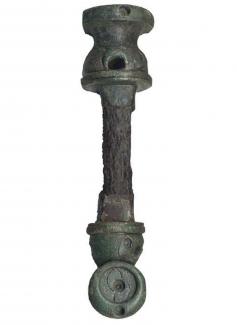Chariot linch pin
Mid-Late Iron Age, about 300BC-43AD
Found with a metal detector at Upham, Hampshire
Linch pins were used to hold the wheels in place on the axles of Iron Age chariots or carts, and were often elaborately decorated. This rare example has a shaft of iron capped by bronze terminals, one shaped like an inverted vase or baluster. The terminals were originally inlaid with pieces of cut glass, heated until soft and then pressed into holes in the metal. Only one or two small traces of red glass now remain.
The Romans were very impressed by the Celts' use of chariots in battle. Julius Caesar himself wrote "In chariot fighting the Britons begin by driving all over the field, hurling their spears. The terror caused by the horses and the noise are enough to throw their enemies into disorder". The chariot drivers also impressed Caesar: "Even on a steep slope they are able to control the horses at full gallop and turn them in a moment".
We can only speculate on how this linch pin came to be lost at Upham. Could it have become detached from a chariot in the heat of a long-forgotten battle, or did it perhaps fall off of an old abandoned cart at the side of an ancient trackway?



